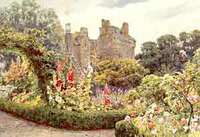If it is open enough to allow of the growth of grass, and the grass has to be cut, and is cut with a machine, then a man with a faghook must follow to cut away slantingly the hard edge of standing grass that is left on each side. For the track of the machine not only leaves the hard, unlovely edges, but also brings into the wood the incongruous sentiment of that discipline of trimness which belongs to the garden, and that, even there in its own place, is often overdone.
Now we are in the true wood path among Oaks and Birches. Looking round, the view is here and there stopped by prosperous-looking Hollies, but for the most part one can see a fair way into the wood. In April the wood floor is plentifully furnished with Daffodils. Here, in the region furthest removed from the white Poets' Daffodil of the upper ground, they are all of trumpet kinds, and the greater number of strong yellow colour. For the Daffodils range through the wood in a regular sequence of kinds that is not only the prettiest way to have them, but that I have often found, in the case of people who did not know their Daffodils well, served to make the whole story of their general kinds and relationships clear and plain; the hybrids of each group standing between the parent kinds; these again leading through other hybrids to further clearly defined species, ending with the pure trumpets. As the sorts are intergrouped at their edges, so that at least two removes are in view at one time, the lesson in the general relationship of kinds is easily learnt.
They are planted not in patches, but in long drifts, a way that not only shows the plant in good number to better advantage, but that is singularly happy in its effect in the woodland landscape. This is specially noticeable towards the close of the day, when the sunlight, yellowing as it nears the horizon, lights up the long stretches of yellow bloom with an increase of colour strength, while the wide-stretching shadow-lengths throw the woodland shades into large phrases of broadened mass, all subdued and harmonised by the same yellow light that illuminates the long level ranks of golden bloom.
From this same walk in June, looking westward through the Birch stems, the value of the careful colour scheme of the Rhododendrons is fully felt. They are about a hundred yards away, and their mass is broken by the groups of intervening tree-trunks; but their brightness is all the more apparent seen from under the nearer roofing mass of tree-top, and the yellowing light makes the intended colour-effect still more successful by throwing its warm tone over the whole.

